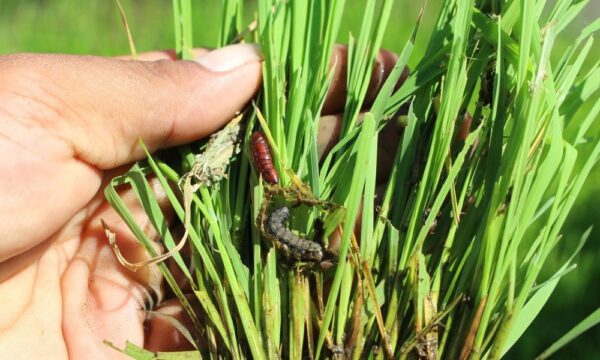By Lauren Bieniek. Reblogged from Agrilinks.

It’s hard to believe that a small worm could destroy millions — millions of tons of crop yields, millions of dollars in farm income and millions of tons of food for families.
I’m talking about the Fall Armyworm (FAW), an invasive pest that has spread quickly across the African continent. Originally from the Americas, FAW was first reported in West Africa in early 2016 and now seriously threatens food supplies across the continent.
The pest has a catastrophic combination of traits. It travels fast (up to 1,600 kilometers in 30 hours). It loves maize, a staple food crop in Africa (as well as 80 other plant species) (CIMMYT), and it’s active at night and burrows into plants, making it hard to spot and treat.
FAW has now been identified in well over 40 African countries (FAO), and agriculture experts estimate the pest could cause losses of up to 20 million metric tons of maize in just 12 African maize producing countries annually (University of Exeter and CABI).
To avoid such losses, it is imperative to get information into the hands of farmers so they can properly identify and manage FAW. However, given the rapid spread and the lack of precedent on the African continent, it has been challenging to get up-to-date and accurate information on the pest.
That’s why Feed the Future, together with Land O’Lakes International Development and the Foundation for Food and Agriculture Research, launched the Fall Armyworm Tech Prize, aimed at leveraging the immense progress in mobile and digital technology to get timely, context-specific and actionable information into the hands of smallholder farmers and those who support them.
From March 28 to May 14, Feed the Future put out a global call for innovative applications, from anyone, anywhere. Twenty of the most promising ideas will come together for a co-creation event in Uganda at the end of June to work with mentors, experts and farmers. After refining their prototypes, our finalists will begin testing their products in the field. Based on the results, and the potential to go to market, five awards will be made this fall for the most compelling solutions.
In total, 228 applications were submitted from 34 countries, a majority of which were from organizations in Africa. The highest participation came from Uganda (52 applications), Nigeria (25), the U.S. (23), Ghana (22) and Kenya (21). Further, over 65 percent of applications came from organizations of less than 10 employees, with over 40 percent from organizations where women comprise nearly half or more of the application team.
So, what types of applications were received? Perhaps of no surprise, all of our finalists use a mobile phone for collecting and/or sharing data and information with farmers. Approximately 75 percent of the solutions can work with just a feature phone, while around 90 percent focus on, or have added services with, a smartphone.
85 percent of the finalists utilize text messaging, either through USSD or SMS platforms, while 60 percent use voice calls or an interactive voice response (IVR) system. Approximately 15 percent leverage radios, and a significant number of the finalists also leverage videos, pictures or photos in their solutions.
Where it gets interesting: the vast majority of finalists (around 80 percent) use data analytics, largely driven by artificial intelligence or machine learning. Another 80 percent (not necessarily the same 80 percent) use spatial or location-based data as a component of their solution. Further, four finalists are proposing to utilize drones, and one will be integrating blockchain technology.*
Across the board, there was a high degree of integration of different types of technologies; no solution relied on a single technology alone. Finalists also placed a strong emphasis on the human element, integrating field agents and experts alongside the technology. There was also strong emphasis on local languages, appropriate and accessible technologies and offline functionality.
I encourage you to check out all 20 of the Fall Armyworm Tech Prize finalists and follow their progress on Twitter (#FallArmyworm) during our co-creation event in Kampala, Uganda, June 26-29. I also encourage your partnership as mentors, resources and potential investors as our finalists develop, test and launch their solutions over the coming months. Feel free to reach out at fawtechprize@nesta.org.uk(link sends e-mail) to get more involved!
*Note: Details on applications are estimates and subject to change as products are refined.
Editor’s note: CABI is evaluating finalists of the Fall Armyworm Tech Prize on behalf of USAID and Nesta.
1 Comment
Leave a Reply
Related News & Blogs
Revolutionizing crop protection: Success of a novel approach to combatting fall armyworm in India
The global battle against invasive pests has found a new champion with pioneering efforts to combat the fall armyworm (Spodoptera frugiperda) in India. This is thanks to a sensor-based pheromone trap – that can be operated remotely anywhere in the worl…
18 August 2023





[…] Twenty Innovators Selected to Tackle Fall Armyworm in Africa with Digital Solutions In “Invasive species” […]